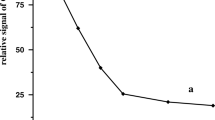Summary
Heavy metals in ground water and tap water can be determined by differential pulse anodic stripping voltammetry (DPASV). This is shown by the quality criteria of the results and by comparison with AAS values. Concentrations down to 0.1 μg/l are detectable. The way of sampling turns out to be quite important for ground water results. Heavy metal content in tap water is influenced by the retention time in the domestic pipes. Stagnation values are up to ten times the minimum concentration measured after heavy discharge. Water temperature is shown to be a good criterion for heavy metal concentration in that case.
Zusammenfassung
Die inverse Voltammetrie ist für Schwermetallbestimmungen in Grund- und Leitungswasser geeignet. Das wird durch die Qualitätskriterien der Werte und den Vergleich mit atomabsorptionsspektrometrischen Messungen gezeigt. Beim Grundwasser tritt die Art der Probenahme als wichtige Einflußgröße hervor. Stagniertes Wasser in Hausinstallationen zeigt bis zu 10fache Konzentrationen, verglichen mit den durch kräftiges Abfließen erreichbaren Minimalwerten. Die Wassertemperatur ist hierfür eine gute Beurteilungshilfe.
Similar content being viewed by others
Literatur
Aurand, K., Hässelbarth, U., Müller, G., Schumacher, W., Steuer, W.: Die Trinkwasser-Verordnung. Berlin: Schmidt 1976
Förstner, U., Wittmann, G. T. W.: Metal Pollution in the Aquatic environment. Berlin, Heidelberg, New York: Springer 1979
Frimmel, F. H.: Z. Wasser Abwasser Forsch. 12, 206–209 (1979)
Frimmel, F. H.: Die hydrochemischen Verhältnisse in der Münchener Schotterebene. Vortragsveranstaltung 14. 2. 1979, Schriftenreihe des Sonderforschungsbereichs 81 der TU München, S. 53–62 (1979)
Kritsotakis, K., Tobschall, H. J.: Fresenius Z. Anal. Chem. 292, 8–12 (1978)
Mart, L.: Fresenius Z. Anal. Chem. 296, 350–357 (1979)
Neeb, R.: Inverse Polarographie und Voltammetrie. Weinheim: Verlag Chemie 1969
Nürnberg, H. W.: Chem.-Ing.-Tech. 51, 717–728 (1979)
Oehme, M., Lund, W.: Fresenius Z. Anal. Chem. 298, 260–268 (1979)
Shumann, M. S., Fogleman, W. W.: Inorganics, J. WPCF 51, 1103–1130 (1979)
Zirino, A., Liebermann, S. H., Clavell, C.: Environ. Sci. Technol. 12, 73–79 (1978)
Author information
Authors and Affiliations
Additional information
Diese Arbeit wurde von der Deutschen Forschungsgemeinschaft unterstützt.
Rights and permissions
About this article
Cite this article
Frimmel, F.H., Immerz, A. Inversvoltammetrische Bestimmungen von Blei, Cadmium, Kupfer und Zink in Grundwasser und Leitungswasser. Z. Anal. Chem. 302, 364–369 (1980). https://doi.org/10.1007/BF00470924
Received:
Issue Date:
DOI: https://doi.org/10.1007/BF00470924




